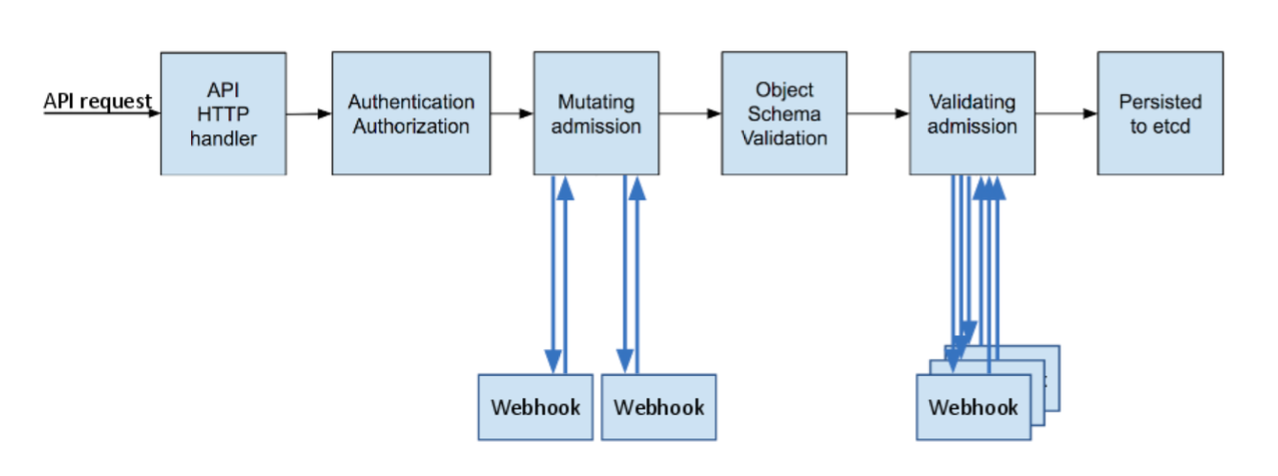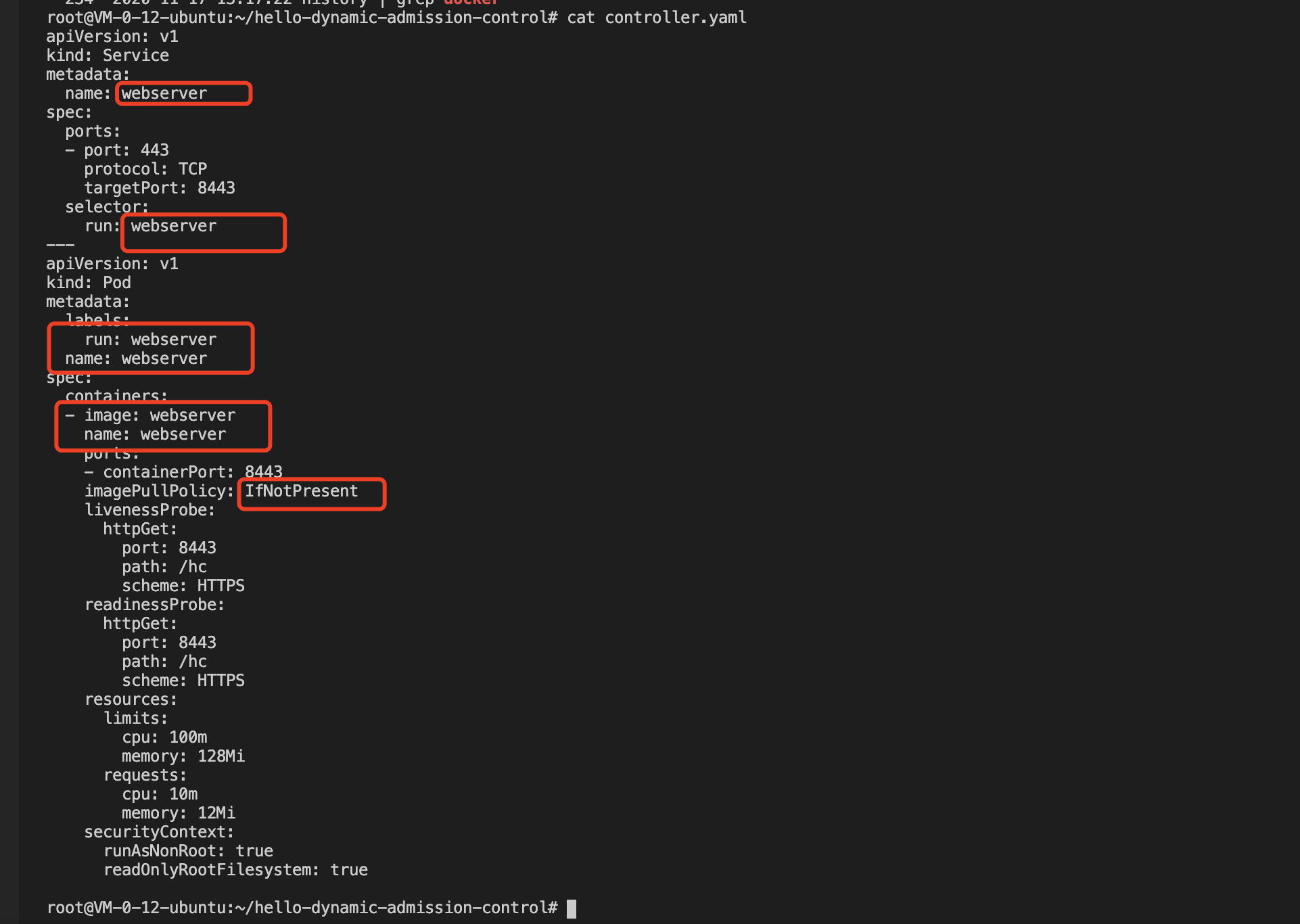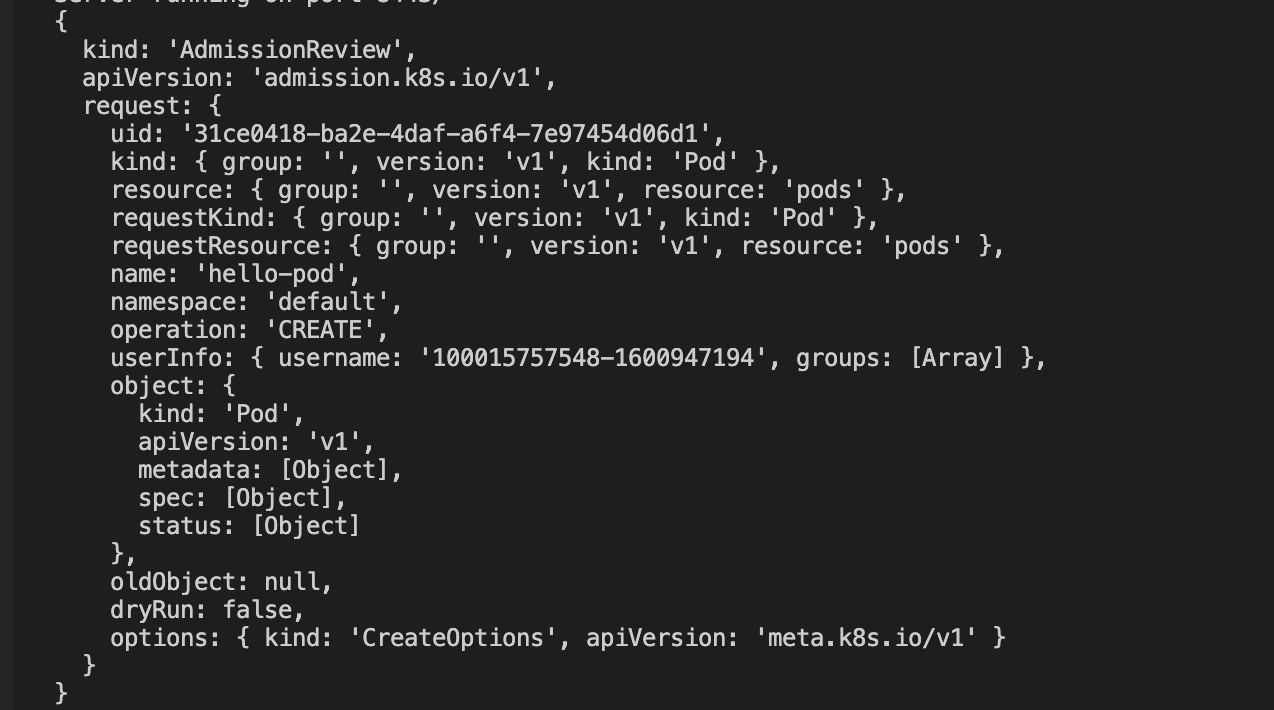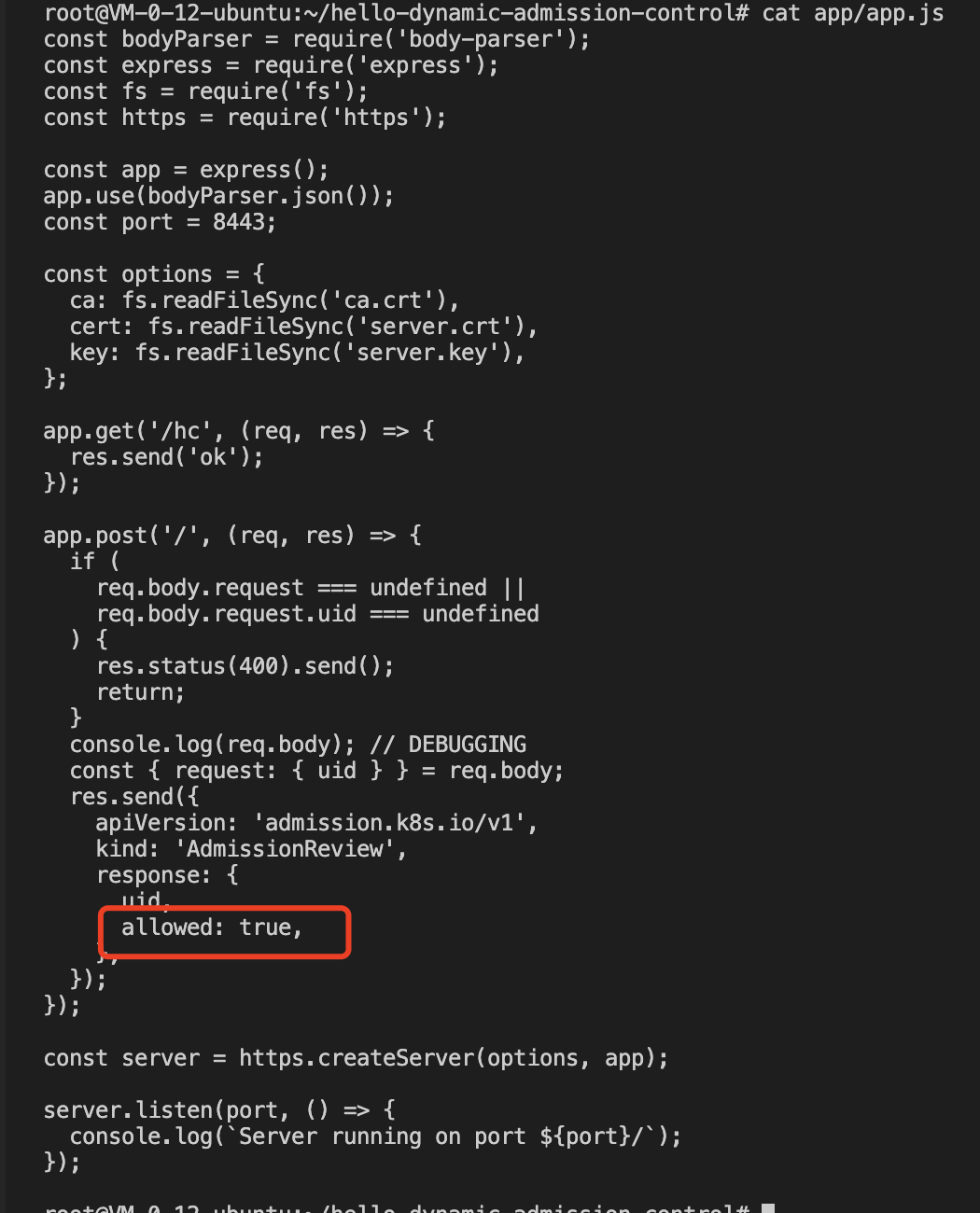在 TKE 中使用动态准入控制器
最后更新时间:2024-12-19 21:49:45
操作场景
动态准入控制器 Webhook 在访问鉴权的过程中可以更改请求对象或完全拒绝该请求,其调用 Webhook 服务的方式使其独立于集群组件。
动态准入控制器具有很大的灵活性,可便捷地进行众多自定义准入控制。下图为动态准入控制在 API 请求调用链的位置,如需了解更多信息,请前往 Kubernetes 官网。


本文将在容器服务 TKE 中实现一个简单的动态准入控制调用示例,您可结合实际需求参考本文进行操作。
操作步骤
查看及验证插件
TKE 现有集群版本(1.10.5及以上)已默认开启了 validating admission webhook 和 mutating admission webhook API。若您的集群版本低于 1.10.5,则可执行以下命令验证当前集群是否开启插件。
kube-apiserver -h | grep enable-admission-plugins
返回结果如已包含 
MutatingAdmissionWebhook 和 ValidatingAdmissionWebhook,则说明当前集群已开启动态准入控制器插件。如下图所示:

签发证书
为确保动态准入控制器调用可信任的 Webhook 服务端,须通过 HTTPS 调用 Webhook 服务(TLS 认证),则需为 Webhook 服务端颁发证书,并且在注册动态准入控制 Webhook 时为
caBundle 字段( ValidatingWebhookConfiguration 和 MutatingAdmissionWebhook 资源清单中的 caBundle 字段)绑定受信任的颁发机构证书(CA)来核验 Webhook 服务端的证书是否可信任。本文介绍了 制作自签证书 及 使用 K8S CSR API 签发证书 两种推荐的颁发证书方法。注意:
当
ValidatingWebhookConfiguration 和 MutatingAdmissionWebhook 使用 clientConfig.service 配置时(Webhook 服务在集群内),为服务器端颁发的证书域名必须为 <svc_name>.<svc_namespace>.svc。方法1:制作自签证书
制作自签证书的方法不依赖于 K8S 集群,比较独立,类似于为网站制作自签证书。目前有很多工具可制作自签证书,本文以使用 Openssl 为例。具体步骤如下:
1. 执行以下命令,生成密钥位数为2048的
ca.key。openssl genrsa -out ca.key 2048
2. 执行以下命令,依据
ca.key 生成 ca.crt。
"webserver.default.svc" 为 Webhook 服务端在集群中的域名,-days 参数用于设置证书有效时间。openssl req -x509 -new -nodes -key ca.key -subj "/CN=webserver.default.svc" -days 10000 -out ca.crt
3. 执行以下命令,生成密钥位数为2048的
server.key。openssl genrsa -out server.key 2048
4. 创建用于生成证书签名请求(CSR)的配置文件
csr.conf。示例如下: [ req ]default_bits = 2048prompt = nodefault_md = sha256distinguished_name = dn[ dn ]C = cnST = shaanxiL = xi'anO = defaultOU = webseverCN = webserver.default.svcsubjectAltName = @alt_names[ alt_names ]DNS.1 = webserver.default.svc[ v3_ext ]authorityKeyIdentifier=keyid,issuer:alwaysbasicConstraints=CA:FALSEkeyUsage=keyEncipherment,dataEnciphermentextendedKeyUsage=serverAuth,clientAuthsubjectAltName=@alt_names
5. 执行以下命令,基于配置文件
csr.conf 生成证书签名请求。openssl req -new -key server.key -out server.csr -config csr.conf
6. 执行以下命令,使用
ca.key、ca.crt 和 server.csr 颁发生成服务器证书(x509签名)。openssl x509 -req -in server.csr -CA ca.crt -CAkey ca.key \\-CAcreateserial -out server.crt -days 10000 \\-extensions v3_ext -extfile csr.conf
7. 执行以下命令,查看 Webhook server 端证书。
openssl x509 -noout -text -in ./server.crt
生成的证书及密钥文件说明如下:
ca.crt:为颁发机构证书。ca.key:为颁发机构证书密钥,用于服务端证书颁发。server.crt:为颁发的服务端证书。server.key:为颁发的服务端证书密钥。方法2:使用 K8S CSR API 签发证书
可使用 K8S 的证书颁发机构系统来下发证书,执行以下脚本可使用 K8S 集群根证书和根密钥签发一个可信任的证书用户。
注意:
用户名需为 Webhook 服务在集群中的域名。
USERNAME='webserver.default.svc' # 设置需要创建的用户名为 Webhook 服务在集群中的域名# 使用 Openssl 生成自签证书 keyopenssl genrsa -out ${USERNAME}.key 2048# 使用 Openssl 生成自签证书 CSR 文件, CN 代表用户名,O 代表组名openssl req -new -key ${USERNAME}.key -out ${USERNAME}.csr -subj "/CN=${USERNAME}/O=${USERNAME}"# 创建 Kubernetes 证书签名请求(CSR)cat <<EOF | kubectl apply -f -apiVersion: certificates.k8s.io/v1beta1kind: CertificateSigningRequestmetadata:name: ${USERNAME}spec:request: $(cat ${USERNAME}.csr | base64 | tr -d '\\n')usages:- digital signature- key encipherment- server authEOF# 证书审批允许信任kubectl certificate approve ${USERNAME}# 获取自签证书 CRTkubectl get csr ${USERNAME} -o jsonpath={.status.certificate} > ${USERNAME}.crt
${USERNAME}.crt:为 Webhook 服务端证书。${USERNAME}.key:为 Webhook 服务端证书密钥。使用示例
本文将使用
ValidatingWebhookConfiguration 资源在 TKE 中实现一个动态准入 Webhook 调用示例。
为了确保可访问性,示例代码 Fork 自 原代码库,示例代码实现了一个简单的动态准入 Webhook 请求和响应的接口,具体接口格式请参见 Webhook 请求和响应 。示例代码可在 示例代码 中获取,本文将使用其作为 Webhook 服务端代码。1. 对应实际使用颁发证书方法,准备
caBundle 内容。若颁发证书使用方法1,则执行以下命令,使用
base64 编码 ca.crt 生成 caBundle 字段内容。cat ca.crt | base64 --wrap=0
若颁发证书使用方法2,集群的根证书即为
caBundle 字段内容。获取步骤如下:1.1.1 登录容器服务控制台,选择左侧导航栏中的集群。
1.1.2 在“集群管理”页面,选择集群 ID。
1.1.3 在集群详情页面,选择左侧的基本信息。
1.1.4 从“基本信息”页面的“集群APIServer信息”模块的 “Kubeconfig” 中的
clusters.cluster[].certificate-authority-data 字段进行获取,该字段已进行 base64 编码,无需再进行处理。2. 复制生成的 
ca.crt(颁发机构证书)、server.crt(HTTPS 证书)及 server.key(HTTPS 密钥) 到项目主目录。如下图所示:

3. 修改项目中的 Dockerfile,添加三个证书文件到容器工作目录。如下图所示:


4. 执行以下命令,构建 Webhook 服务端镜像。
docker build -t webserver .
5. 部署一个域名为 “weserver.default.svc” 的 Webhook 后端服务,修改适配后的 
controller.yaml 如下所示:

6. 注册创建类型为 
ValidatingWebhookConfiguration 的资源,修改适配项目中的 admission.yaml 文件。如下图所示:
本示例配置的 Webhook 触发规则为:当创建 pods类型、API 版本 “v1” 时触发调用,clientConfig 配置对应上述在集群中创建的 Webhook 后端服务,caBundle 字段内容为证书颁发方法一获取的 ca.crt 内容。

7. 注册好后创建一个 Pod 类型且 API 版本为 “v1” 的测试资源。如下图所示:


8. 测试代码已打印请求日志,查看 Webhook 服务端日志即可查看动态准入控制器触发了 webhook 调用。如下图所示:


9. 此时查看创建的测试 pod 已成功创建,由于测试 Webhook 服务端代码已具备 

allowed: true 配置项,即可创建成功该测试 pod。如下图所示:

controller.yaml 和 admission.yaml 资源。当再次尝试创建 pods 资源时请求被动态准入拦截,则说明配置的动态准入策略已生效。如下图所示:

总结
本文主要介绍了动态准入控制器 Webhook 的概念和作用、如何在 TKE 集群中签发动态准入控制器所需的证书,并使用简单示例演示如何配置和使用动态准入 Webhook 功能。
参考资料
文档反馈

